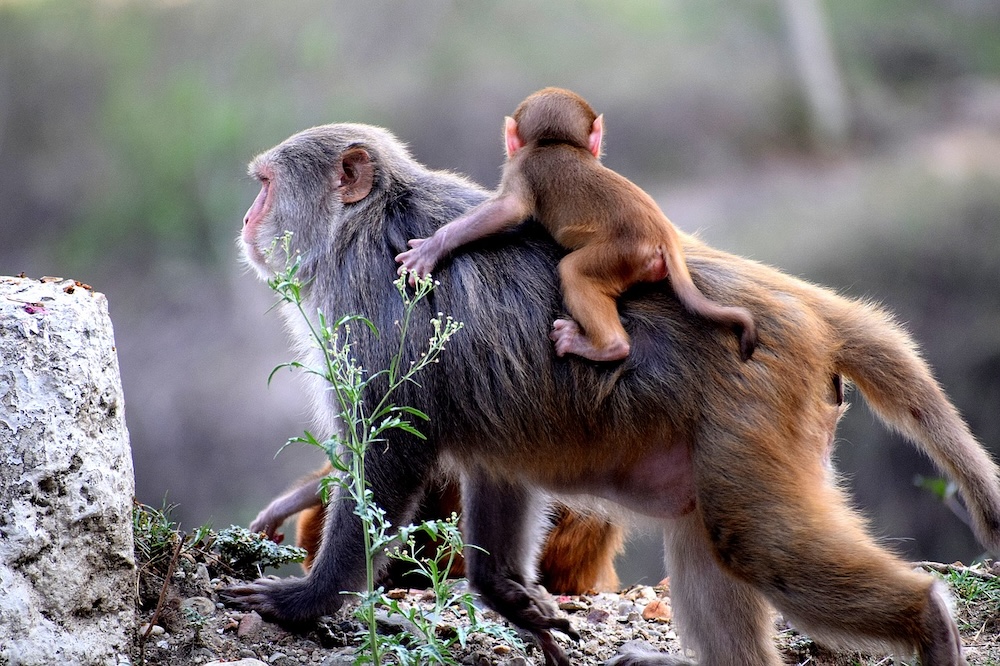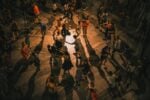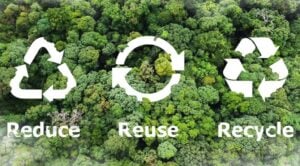
In 2022, I planned a trip with a friend to the Jigokudani Snow Monkey Park in Nagano. I’d seen countless pictures of cute and furry macaques bathing in hot springs and decided a long time ago that it was on my bucket list to see. Well, in my research, I overlooked the very important fact that it would be mid fall (late October) when we went, which was prime foraging and mating season for the monkeys, and meant that the day we paid them a visit, they were nowhere to be found.
However! If I had known how many other opportunities there are to bask in the snow monkeys’ presence outside of the Nagano area, I may not have felt so defeated that day. Wherever you find yourself in Japan, there’s a chance to get (not too) up close and personal with them.
Jigokudani Yaen Koen
Of course, the most famous snow monkey park is undoubtedly Jigokudani Yaen Kōen (地獄谷野猿公苑). Macaques appear countless times photographed chest-deep in steaming hot springs aimed at both visitors to Japan and Japanese residents, beckoning them to come visit. Admittedly, it is difficult to resist. I mean, just look at them!
It is certainly worth experiencing if you have the means to get to Nagano. If you take a city bus, it will drop you about a 20-minute trek up to the park. However, it’s not at all difficult – the most taxing part is probably the sets of stairs at the very end, but as long as you’re at least generally physically fit, you should be able to make it just fine.
Perhaps because of how famous Nagano snow monkeys are for their habit of bathing in hot springs, it might surprise you to know that this has not always been a natural inclination of theirs. Many decades ago, as humans began to move closer to the monkeys’ natural habitat, encounters between the two began to occur with increasing frequency. In an effort to entice them back into the mountains, they were offered food, most notably by an inn next to the present-day monkey hot springs called Korakukan. The monkeys eventually made their way back to the mountains. The story of how the monkeys came to soak in the hot springs themselves varies depending on who you ask, from “monkey see, monkey do”-ing as humans did to accidentally falling into the water. However it may have come to pass, soon the monkeys were bathing in and hanging out around the inn’s own hot springs. To maintain proper hygiene and address other issues that came with this newfound macaque hobby, a special onsen for them was soon built up the hill from Korakukan. Since then, the snow monkeys have graced the monkey park with their presence on a regular basis.

When in Kansai…
If you find yourself closer to the Kansai area, consider visiting the monkey park in Arashiyama. That’s right, after a quick morning walk through the famous bamboo forest, you can head down the road in time for when the park opens at 9am. The hike up to the park is, again, about 20 minutes. This one had a slightly steeper incline and more stairs. I went with a family member who was very used to lots of walking, but struggled a bit to make it to the top. If you’re not the best at uphill walks, just plan to rest a couple of times on the benches provided along the trail.
Once in the park, you’ll have plenty of spots from which to watch the monkeys playing around. While there’s no hot spring at this monkey park, there is a tiny pond where, if you get lucky, you might see one of the monkeys push his or her friend into the water. This park also has a feeding cage. Don’t worry, it’s the humans who are in cages in this case! Here, you can purchase small bags of macaque-safe food (peanuts or apple slices when I went) which you can pass to the monkeys from behind bars.
Takasakiyama Natural Zoological Garden
If you find yourself in Kyūshū instead of Honshu, head over to Oita prefecture. While its claim to fame is, of course, the plethora of onsen, particularly in the town of Beppu, there is more to this prefecture than a relaxing hot bath.
From Beppu Station, for example, you can reach Takasakiyama Shizen Dōbutsuen (高崎山自然動物園) in about 20 minutes by bus. They run about once every hour until 1:54 pm. Of course, you can also drive, since the park has its own parking area. From either the bus stop or the parking lot, the park’s entrance is a quick 3-minute walk. As seems to be the theme with monkey parks in Japan, there is a hiking component, however the climb up to the monkeys this time will only set you back 5 minutes. There is also a quaint cable car that can take you up the slope for 110 yen roundtrip, but it doesn’t save you much time. Personally, I don’t think it’s worth it.
But the monkeys always sure are! If you make it to these parks at the right time, you can catch the monkeys’ feeding time. And trust me, this isn’t something you want to miss.

Some important things to note
Safety
Although it can be very easy to get caught up in the cuteness and hilarity of watching these opposable-thumbed creatures scratch their butts or groom each other (sometimes in that order), it’s important to keep in mind that these are still wild animals. Before entering any monkey park in Japan, you’ll see a warnings against things like
- Making eye contact with the monkeys
- Feeding the monkey anything other than what the park specifically provides as monkey feed
- Crouching down close to the monkeys, as this can be taken as a sign of aggression
- Touching the monkeys
Some of these might seem like common sense, but usually if they’ve been made an official rule, it’s because for some people it’s not quite so common.
Something else to keep in mind is that you should keep your belongings secured in a bag with a zipper or similar closure. Monkeys are curious and especially interested in things like that half a 7-11 onigiri you didn’t finish earlier.
Seasonality
As I mentioned earlier, my carelessness when it came to checking how the monkeys’ behavior changes throughout the seasons cost me dearly on my trip to Nagano. Don’t make this mistake! For example, in winter time you are almost guaranteed to see the macaques bathing in their personal onsen at Jigokudani Monkey Park. In late October, your chances become slimmer.
You can also plan your trip to these parks for more adorable reasons, like springtime to see newborn monkeys clinging to their mom or hopping around the park. There really is nothing like watching the maternal instincts that we see in humans reflected so clearly in these animals.
I have found the residents of Jigokudani Monkey Park to be the most finicky, as there are days where they only come down from the mountains for a couple of hours, and sometimes not at all. I recommend taking a look at the information posted on the park’s official website when deciding which season to visit.
One of my favorite things about monkey parks in Japan is that they are free roaming. In other words, there are no enclosures to keep them around, and they can come and go as they wish. This makes it much easier to enjoy the experience of watching these cute and oftentimes hilarious fluffballs. Whichever park you decide to visit, you’re guaranteed to be won over by their goofy, laid-back disposition.















